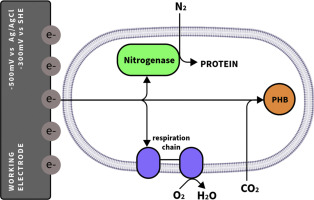Electrochimica Acta, Volume 505, 2024
Abstract
Azotobacter vinelandii has been studied for over 100 years since its discovery as an obligate aerobic N2-fixing organism. This model bacterium enabled remarkable discoveries related to aerobic N2-fixation, respiration, microbial physiology, H2 production and assimilation, and enzyme kinetics, among others. Additionally, it is of great industrial interest due to its ability to produce bioplastics and alginate, and N2-fixation as an environmentally-friendly alternative to synthetic N-fertilizer in sustainable agriculture and industrial fermentations. Since these metabolic processes and derived applications are very-demanding in terms of cellular energy, this study aimed to analyze whether A. vinelandii can take electrons from a cathodically polarized electrode to enhance its metabolism. The observed electrochemical response and biomass composition indicated that, under microaerobic conditions, A. vinelandii can take electrons from an electrode to produce polyhydroxybutyrate-rich biomass even when no other carbon source than CO2 from the air was supplied. The addition of sucrose boosted not only polyhydroxybutyrate but also bulk protein accumulation suggesting a mixotrophic life-style comprising both electro-autotrophy from CO2 and electro-diazotrophy from N2. These findings open new venues for understanding the metabolic capabilities and flexibility of this remarkable bacterium, and pave the way to possibly novel biotechnological processes and applications.
Graphical abstract
